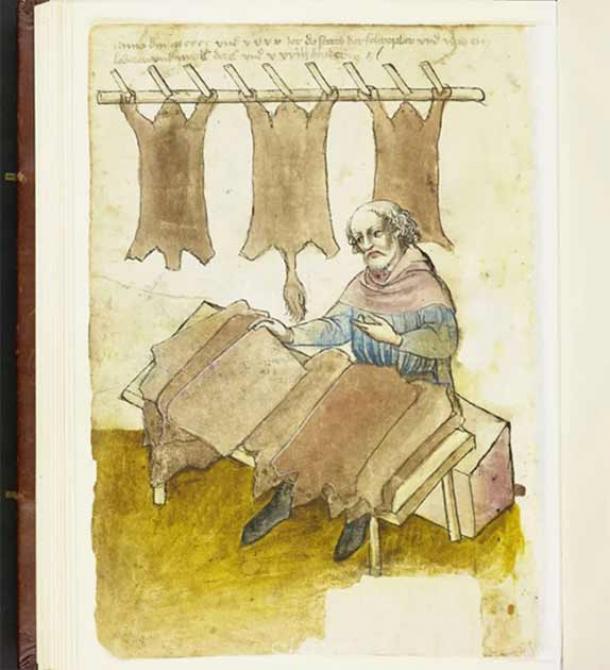
Massive Medieval Tannery Identified at Spectacular Fountains Abbey
The original purpose of a mysterious patch of land beside England’s Fountains Abbey has finally been deciphered. Experts have concluded that it’s the largest and best-preserved tannery ever discovered at a medieval abbey in Britain.
Unearthing the Source of Income at Fountains Abbey
Founded in 1132 AD, Fountains Abbey was built near the River Skell about 3 miles (5 km) south-west of Ripon, in North Yorkshire, England. Representing not only the largest and one of the best-preserved Cistercian monasteries in England, this medieval religious powerhouse was also one of the wealthiest until it was dissolved by King Henry VIII of England in 1539.
- The Codex Amiatinus: The Skins of 500 Calves Were Used to Create this Monumental Manuscript
- 13th Century Cat- and Goat-Hide Shop Excavated in England
Until now it has always been believed that the abbey’s legendary riches had been made from the rearing of cattle, horses and sheep and the production of wool, and from the mining and quarrying of lead and stones, respectively. But now, a new and important discovery has been made showing an entirely new industrial income source at Fountains Abbey.

Ground Penetrating Radar technology has revealed signs of a medieval tannery at Fountains Abbey where a long “bowling alley” extension has puzzled archaeologists for a long time. (University of Bradford)
Scanning Through Layers of Time to Understand the Past
According to a recent National Trust article, the nature of a long extension to the east side of Fountains Abbey, described as resembling a bowling alley, had been a longstanding archaeological mystery. Now, a team of scientists from the University of Bradford, Mala UK, Geoscan Research and Magnitude Surveys, has applied ground-penetrating radar (GPR) to reveal the original purpose of this grandiose architectural anomaly.
Hilary McGrady, Director-General of the National Trust says that for most of the 20th century an incorrect assumption was made “that pretty much everything to be found had been found” and “that there was no further archaeological research work to do at Fountains Abbey.” However, the project team’s recent work with the University of Bradford demonstrated the diametrical opposite.
The new GPR scans revealed the foundations of two hitherto unknown and “unexpectedly massive” buildings at Fountains Abbey. The largest building measured as much as 6 meters (19.7 ft) wide and 32 meters (105 ft) long, and it was 2 stories high. Chris Gaffney, Professor of Archaeological Sciences at the University of Bradford, says the new geophysical survey at Fountains Abbey provides “stunning, unexpected and intriguing glimpses into life in the past at the site.”

Man sorting skins after drying during leather production. (Nürnberg City Library)
Fountains Abbey Filled with Devilish Stench
The two buildings were found to be surrounded with lined pits and tanks, which are all tools used by tanners. Tanning is the process of treating animal skins and hides to make leather. This was important in ancient times because tanning increased the durability of raw materials, and therefore their longevity.
Monastic settlements required large quantities of top quality leather for writing on, as well as for binding sacred texts and books. Furthermore, an article in The Guardian says abbeys sold leather belts and bedding to the public. However, even after accounting for this level of demand, the sheer scale of the tannery has “surprised archaeologists,” according to the National Trust report.
National Trust archaeologist Mark Newman explained to the BBC that a tannery of this size indicates “an industrial scale production site,” that must have required huge herds of animals to sustain it. The researcher noted that while these days Fountains Abbey is “an oasis of tranquility” this was not always the case. While at the height of operation in the 12th and 13th centuries the entire landscape surrounding this house of God was filled with “noise, activity and stench,” from the huge tannery.

Leather-bound ancient text from Fountains Abbey. (British Library)
An Industrial Scale Tannery for the Preservation of History
A key job of medieval monks was the copying of ancient texts onto more modern media. Considering this, the project team say this newly discovered tannery was where “all the vellum and parchment was produced for the scribes within the abbey.” Mark Newman added that the impressive scale of the tanning operations confirms historic models that Cistercian monks at Fountains Abbey, and at other monastic settlements in Britain, “were pioneering farmers and land managers on an industrial scale.”
- Blue Pigment Found on Medieval Teeth Reveals Secret Existence of Female Scribes
- Experts Solve 1000-Year-Old Mystery of Rare Medieval Blue Ink
Newman reasoned that “they [the monks] had to be, to have supported the enormous religious community that rapidly built up and the vast building projects they undertook, in praise of God.” It has always been known that lay brothers at Fountains Abbey became very wealthy through wool production, lead mining, cattle rearing, horse breeding and stone quarrying, but it seems tanning was also a major income source at perhaps the most famous Cistercian Abbey in Britain.
Top image: Fountains Abbey in northern Yorkshire. Source: Russell / Adobe Stock
By Ashley Cowie















